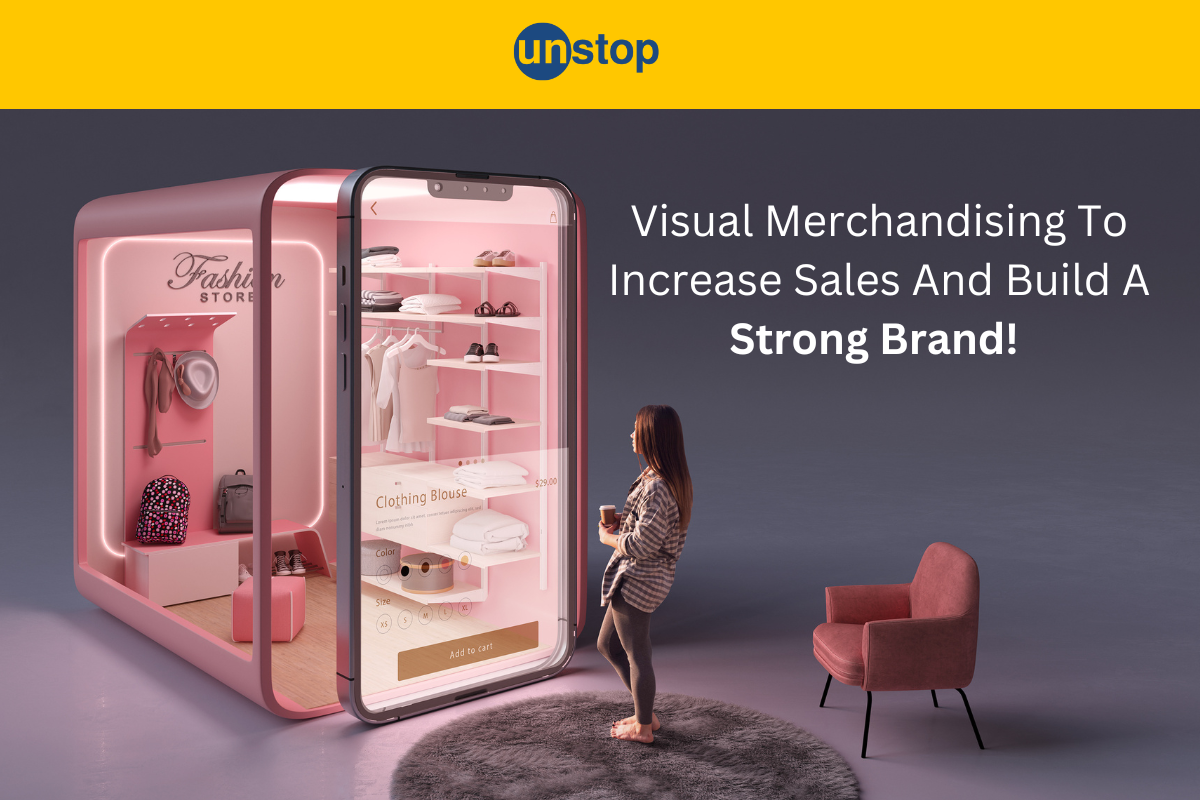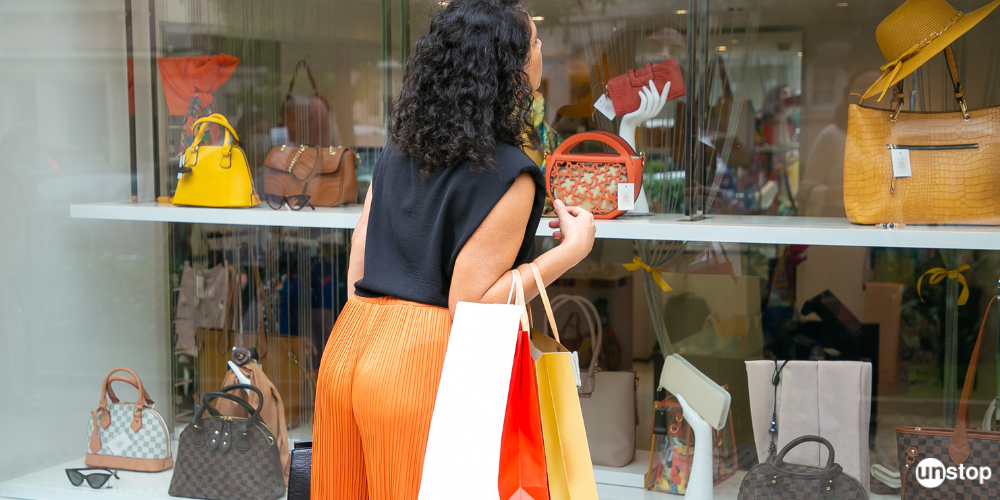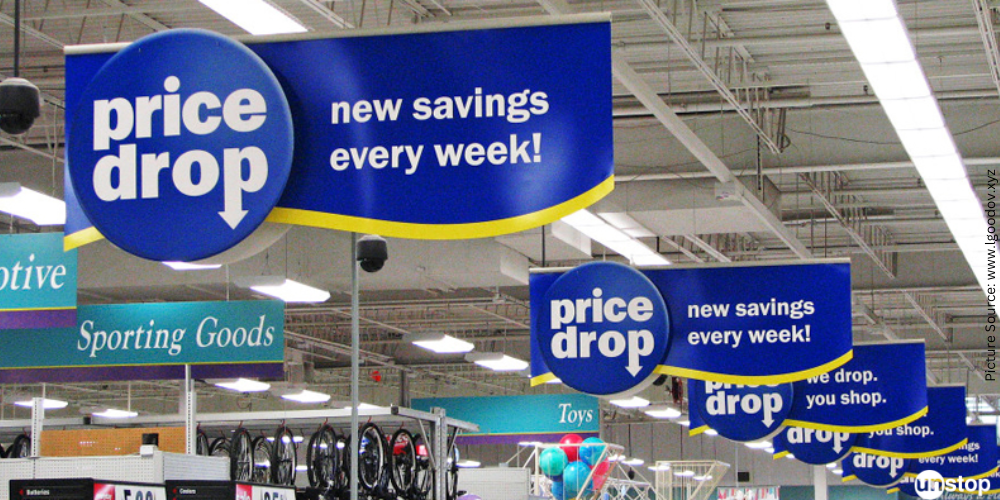- Visual Merchandising Meaning & Examples
- Visual Merchandising: Importance and Types
- Objectives of Visual Merchandising
- Key Elements of Visual Merchandising
- Aligning Retail Brand Strategy with Visual Merchandising Expertise
- Examples of Brands That Pull Off Effective Visual Merchandising
- Harnessing the Power of Visual Merchandising
- FAQs
What Is Visual Merchandising: Meaning, Benefits, Examples & Tips!

Visual merchandising is the art of captivating customers by creating an immersive shopping experience that leaves a lasting impression. Effective visual merchandising techniques not only showcase products in an attractive manner but also help build brand awareness.
From strategically arranging products in a retail store on the sales floor to utilizing white space and transition zones, retail merchandisers guide customers through a curated shopping journey using a merchandising strategy. Let’s explore this topic in detail and understand the types and importance of Visual Merchandising.
Visual Merchandising Meaning & Examples
Before we go any further, it is important to know what is visual merchandising? Let’s give you an example. Imagine the window displays of high-end fashion brands. These displays are meticulously designed to showcase the latest collections and create a sense of luxury and exclusivity. The visual merchandiser uses mannequins in stylish outfits, carefully arranged accessories, and creative lighting techniques to capture the attention of passersby and attract them to step inside the retail store.
Thus, visual merchandising involves creating visually appealing displays to attract customers and enhance the overall shopping experience. It is a strategic approach that combines art, design, and psychology to maximize sales and create a positive brand image.
Visual merchandisers carefully consider factors such as product placement, color coordination, and signage to guide customers through the store and encourage them to make purchases. For instance, in a grocery store, fresh produce is often placed near the entrance to create a vibrant and inviting atmosphere. Similarly, items that are frequently purchased together, such as pasta and sauce, are strategically positioned next to each other to encourage cross-selling.
Is visual merchandising only related to physical displays? In addition to physical displays, visual merchandising also extends to online platforms. E-commerce websites use various techniques to enhance the visual appeal of their product pages. High-quality product images, detailed descriptions, and user-friendly interfaces all contribute to creating a seamless and visually engaging online shopping experience.
Visual merchandising is also utilized in sectors such as hospitality and entertainment. For example, hotels often use visually appealing lobby displays to create a welcoming atmosphere and showcase their services. Similarly, theme parks incorporate vibrant colors, themed decorations, and engaging signage to create a visually immersive and memorable experience for visitors.
Hence, visual merchandising plays a vital role in attracting customers, increasing sales, and building a strong brand image for companies across sectors. Through carefully curated displays and strategic placement of products, retailers can create visually appealing environments that captivate customers and enhance their overall sales.
Other Interesting Examples of Visual Merchandising
- Window Displays: A fashion store uses mannequins in stylish outfits with seasonal props to attract customers.
- Product Grouping: A grocery store places all BBQ essentials together (grills, meats, sauces) for convenience and upselling.
- Thematic Displays: A bookstore features a 'Back to School' section with educational books and school supplies set up with a classroom theme.
- Interactive Displays: An electronics store allows customers to try new gadgets in a designated area to increase engagement.
- Point-of-Sale Displays: A cosmetics store places small, high-margin products like lip balms and travel-sized items near the checkout to encourage impulse buys.
Visual Merchandising: Importance and Types
Visual merchandising has a significant impact on customer perception and buying behavior. When executed effectively, it can differentiate a store from its competitors, ultimately leading to increased sales. Here are some key reasons why visual merchandising is important:
-
Brand Image: Well-designed window displays and arrangements help establish a distinct brand identity, making the store memorable in consumers' minds.
-
Engagement: Eye-catching visuals capture attention and engage customers, encouraging them to explore products further.
-
Product Highlighting: Strategic placement of products through visual merchandising draws attention to specific items or promotions, increasing their visibility and desirability.
-
Atmosphere Creation: Thoughtfully designed store layouts, lighting, colors, and music create an inviting atmosphere that enhances the overall shopping experience.
Types of Visual Merchandising
There are several types of visual merchandising techniques that retailers employ to entice customers. Here are three common ones:
Window Displays: These captivating installations showcase featured products or themes in storefront windows, enticing passersby to enter the store.

Product Placement: This involves arranging merchandise in an appealing manner throughout the store, ensuring easy navigation for customers while highlighting key items or promotions.

Signage: Effective signage is an important element of visual merchandising. It communicates important information, such as sales offers or product details, using clear typography, attractive graphics, and appropriate placement within the store.

Quick Tips for Window Displays: 1. Keep it simple and clutter-free to grab attention 2. Change displays regularly to keep customers engaged and curious 3. Place interesting elements in the display at eye level 4. Keep the viewpoint of passersby into consideration
Objectives of Visual Merchandising
Visual merchandising serves several key objectives that contribute to the success of a retail business. By understanding these objectives, retailers can effectively utilize visual merchandising strategies to drive sales and create a memorable shopping experience for customers.
Drive Sales and Attract Attention
The primary objective of visual merchandising is to drive sales by capturing customers' attention. Through eye-catching displays, retailers can attract potential buyers and encourage them to explore products further. By strategically placing products in visually appealing arrangements, retailers can increase the likelihood of impulse purchases and boost overall sales.
Communicate Brand Values and Identity
Visual merchandising plays a crucial role in communicating a brand's values and identity. Through creative displays, retailers can showcase their unique selling propositions, such as sustainability, luxury, or affordability. By aligning visual elements with the brand's image, retailers can establish a strong connection with their target audience and build brand loyalty.
Educate Customers about Products
Another objective of visual merchandising is to educate customers about product features or promotions. Effective use of signage, labels, and product demonstrations helps customers understand the benefits and functionalities of different items. This information empowers customers to make informed purchase decisions while also increasing their perceived value of the products.
Create a Memorable Shopping Experience
Visual merchandising aims to create a memorable shopping experience that leaves a lasting impression on customers. By curating an aesthetically pleasing environment with attractive displays, lighting techniques, and sensory elements like music or scents, retailers can enhance the overall ambiance of the store. This immersive experience not only encourages repeat visits but also generates positive word-of-mouth recommendations from satisfied customers.
Key Elements of Visual Merchandising
The major elements of successful visual merchandising are as follows:
1. Lighting: Highlighting Products and Creating Ambiance
Proper lighting is an essential element of successful visual merchandising. It serves two crucial purposes: highlighting products and creating the right ambiance within the store. Well-placed lights can draw attention to specific items, making them stand out from the rest. Bright lights can create a vibrant and energetic atmosphere, while softer lighting can evoke a sense of intimacy or luxury.
2. Color Schemes: Evoking Desired Emotions and Brand Associations
Carefully choosing color schemes is another important factor in visual merchandising. Colors have the power to evoke emotions and associations with a brand. For example, warm colors like red and orange can create a sense of excitement or urgency, while cool colors like blue and green can convey calmness or trustworthiness. The use of consistent color schemes throughout the store helps reinforce brand identity and creates a cohesive shopping experience for customers.
3. Product Arrangement: Making it Easy for Customers to Navigate
An organized layout is key to successful visual merchandising. Product arrangement should be logical, making it easy for customers to navigate through the store. Similar items should be grouped together, creating clear sections within the store. This allows customers to find what they are looking for quickly and efficiently.
4. Attention-Grabbing Focal Points
Creating attention-grabbing focal points is an effective way to draw customers into the store or specific areas within it. These focal points can be eye-catching displays at the storefront or strategically placed throughout the store. They serve as magnets that attract customers' attention and entice them to explore further.
AR in Visual Merchandising!
To provide a more interactive and personalized shopping experience, Sephora has implemented Augmented Reality (AR) technology in their mobile app. Users can now virtually try on different makeup products, such as lipstick, eyeshadow, and foundation, using their smartphone's camera, allowing the customers to see how the products will look on their own faces before making a purchase. Indian optical prescription eyewear retail chain, Lenskart, has also introduced the technology for real-time eyeglasses trials.
Aligning Retail Brand Strategy with Visual Merchandising Expertise
To build brand equity, it is crucial to maintain consistency between visual merchandising and brand messaging. By aligning these two elements, retailers can create a cohesive and memorable shopping experience for their customers. Understanding the preferences of the target audience is key in tailoring visual elements accordingly.
Collaboration between marketing teams and visual merchandisers plays a vital role in ensuring that branding efforts are aligned. When these two groups work together, they can effectively communicate the brand's message through visual displays and store layouts. This collaboration also helps in integrating promotional campaigns seamlessly into the retail space.
Regular evaluation of visual merchandising strategies is essential to stay aligned with evolving market trends. Retailers need to monitor customer feedback, analyze sales data, and keep an eye on competitors to make informed decisions about their visual displays. By staying up-to-date with industry trends, retailers can ensure that their visual merchandising remains fresh and relevant.
Examples of Brands That Pull Off Effective Visual Merchandising
Eye-Catching Window Displays
Window displays are a prime example of effective visual merchandising. By creating captivating and visually appealing showcases, retailers can grab the attention of passersby and entice them to step inside. For instance:
-
Fabindia: Fabindia is a well-known retail brand in India that specializes in handcrafted products made by artisans across the country. They are known for their vibrant and visually appealing window displays that showcase their unique products. Fabindia often uses elements like colorful textiles, intricate patterns, and traditional Indian motifs to create eye-catching displays that attract the attention of passersby.
-
Apple: Apple's minimalist approach to window displays focuses on sleek product presentations with minimal distractions, allowing its innovative technology to speak for itself.
Well-Designed Product Displays
Effective product displays within a store can significantly impact customer engagement and sales. Retailers understand the importance of presenting products in an enticing manner. Here are a few examples:
-
IKEA: IKEA excels at showcasing its furniture by setting up fully furnished rooms within its stores. This allows customers to visualize how the products would look in their own homes.
-
Lakme’: Whether it's their makeup counters in retail stores or their promotional stands at events, Lakmé ensures that their displays are catchy and attractive. They use a combination of vibrant colors, sleek designs, and strategic placement to showcase their products in the most appealing way possible. From their elegant glass display cases to their interactive digital screens, Lakmé's displays create a visually stunning and immersive experience for customers.
Interactive In-store Experiences
Retailers have started incorporating interactive elements into their visual merchandising strategies to engage the target customer on a deeper level. Here are two examples:
-
Nike: Nike's flagship stores often feature interactive zones where customers can test out new shoes or experience virtual reality simulations related to sports.
-
Hamleys: Hamleys stores create unique and engaging in-store experiences for children by incorporating interactive elements. Kids can participate in various activities and play with different toys in the dedicated play areas. Hamleys even organizes special events and shows in-store to entertain and engage children, where they have live performances, magic shows, puppet shows, and character appearances that create a vibrant and exciting atmosphere for kids.
Visual merchandising is an effective way for retailers to create memorable experiences for customers while showcasing their products in the best light possible. By implementing eye-catching window displays, well-designed product arrangements, and interactive in-store experiences, retailers can capture attention, drive foot traffic, and ultimately boost sales.
Harnessing the Power of Visual Merchandising
Visual merchandising plays a significant role in capturing customers' attention, enhancing their shopping experience, and ultimately driving sales. By strategically arranging products, creating visually appealing displays, and utilizing various elements such as lighting and signage, retailers can effectively communicate their brand message and influence consumer behavior. The importance of visual merchandising cannot be overstated, as it has a direct impact on customer engagement, brand perception, and overall store performance.
To optimize the power of visual merchandising, retailers must understand its objectives and key elements. The objectives include attracting customers to the store, guiding them through the space efficiently, increasing dwell time, encouraging impulse purchases, and promoting brand loyalty.
Successful visual merchandising relies on key elements such as product placement, color coordination, storytelling through displays, use of props and mannequins, effective signage and pricing strategies. It is essential for retailers to align their retail brand strategy with visual merchandising expertise to ensure consistency across all touchpoints.
In conclusion, visual merchandising is a powerful tool that enables retailers to create engaging environments that captivate customers and drive sales. By harnessing its potential through strategic planning and implementation of key elements discussed earlier in this blog post series - from understanding the importance of visual merchandising to aligning it with retail brand strategy - businesses can enhance their overall customer experience while increasing revenue.
To stay ahead in today's competitive market landscape, where consumers are increasingly demanding visually stimulating experiences both online and offline, retailers should invest in mastering the art of visual merchandising.
FAQs
What role does lighting play in visual merchandising?
Lighting is a critical element in visual merchandising as it sets the mood within a retail environment. Properly placed lighting fixtures can highlight specific products or areas within the store while creating an inviting ambiance for shoppers. Different types of lighting, such as spotlights, accent lights, and ambient lighting, can be used to create focal points, enhance product visibility, and evoke desired emotions.
How can visual merchandising impact customer engagement?
Visual merchandising has a direct impact on customer engagement by capturing their attention and creating an immersive shopping experience. Well-designed displays and visually appealing arrangements not only attract customers but also encourage them to explore the store further. By effectively utilizing various elements such as colors, textures, and props, retailers can evoke emotions that resonate with their target audience, leading to increased customer satisfaction and loyalty.
What are some common mistakes to avoid in visual merchandising?
Some common mistakes to avoid in visual merchandising include overcrowding displays with too many products, neglecting proper signage and pricing information, failing to update displays regularly, and lacking consistency in brand messaging. It is crucial for retailers to maintain clean and organized displays while ensuring that they align with the overall brand image and strategy.
How can I measure the effectiveness of my visual merchandising efforts?
Measuring the effectiveness of visual merchandising efforts can be done through various methods such as tracking sales data before and after implementing changes, conducting customer surveys or feedback forms regarding their shopping experience, and monitoring foot traffic patterns within the store using technology like heat mapping or video analytics. These insights will help retailers assess the impact of their visual merchandising strategies on customer behavior and make informed decisions for future improvements.
What are some emerging trends in visual merchandising?
Some emerging trends in visual merchandising include incorporating interactive elements such as digital screens or virtual reality experiences into displays, utilizing sustainable materials for eco-friendly presentations, and embracing minimalistic aesthetics for a clean and modern look. Retailers are also exploring personalized experiences by leveraging technologies like augmented reality (AR) or implementing dynamic pricing strategies based on real-time data analysis.
Alekhya Chakrabarty is a father, a doodler, a trivia buff, a sports fanatic and a lifelong student of marketing. Alekhya is the VP of Marketing & Growth at Unstop, the engagement and hiring platform which connects students and graduates with opportunities. He has over a decade and a half of experience in driving revenue and building brands with the likes of Nestle, HUL and ITC. He is an alumnus of IMT Ghaziabad and in his last stint he was leading the marketing function at Sunstone, a higher education startup. Alekhya has been recognised as a ‘Top Voice’ on LinkedIn for Digital Marketing & Brand Management. He runs a marketing podcast titled East India Marketing Company to drive conversations around growth, content, culture and commerce.
Login to continue reading
And access exclusive content, personalized recommendations, and career-boosting opportunities.
Subscribe
to our newsletter
















Comments
Add comment